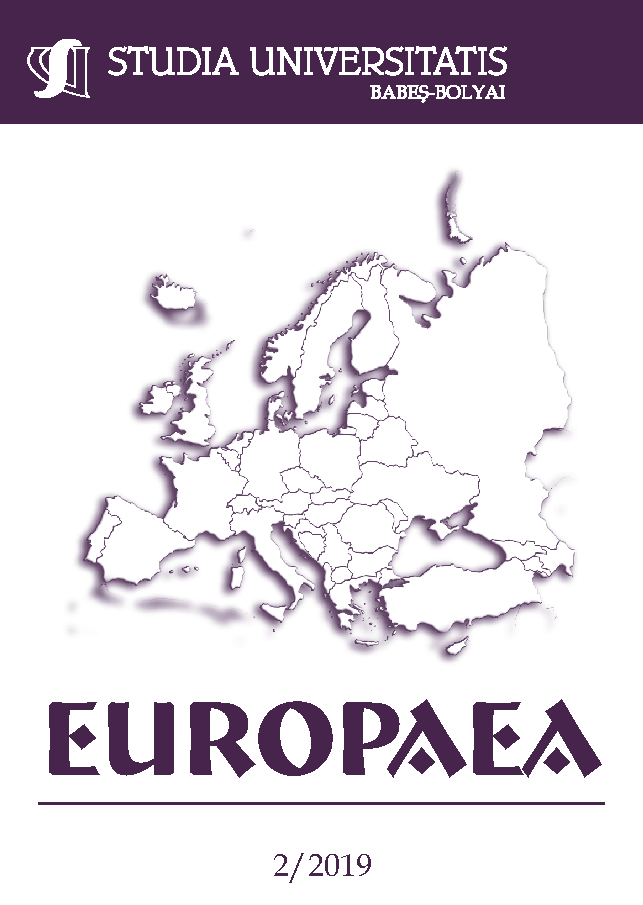RESPONSIBILITY TO PROTECT AND HUMAN SECURITY IN UN’S INVOLVEMENT IN LIBYA
DOI:
https://doi.org/10.24193/subbeuropaea.2019.2.10Keywords:
United Nations, responsibility to protect, Libya, human security, humanitarian interventionAbstract
The article discusses the responsibility to protect (RtoP) and the shift from a right for humanitarian intervention towards a global responsibility to protect civilians, as exemplified by the wording of Resolutions 1970 and 1973. The main goal of the article is to analyse the response of the United Nations to the crisis in Libya and discuss the ways in which responsibility to protect and human security were incorporated throughout the involvement in Libya. The article is structured in three main parts. The first one provides a brief overview of the essentials of the responsibility to protect while the second one focuses on the UN’s incorporation of RtoP. Finally, the last part tackles the degree to which the intervention in Libya reflected an adequate and consistent RtoP framework.References
Annan, Kofi A. (2000), We the Peoples: The Role of the United Nations in the twenty-first century, Report of the Secretary-General, The Millennium Assembly of the United Nations.
Annan, Kofi A. (2005), In Larger Freedom: Towards Development, Security and Human Rights for All, New York: United Nations.
Bellamy, Alex (2011), “The Responsibility to Protect and the Problem of Regime Change”, in Thomas G. Weiss et. al., The Responsibility to Protect: Challenges, Opportunities, in Light of the Libyan Intervention, e-International Relations [https://www.e-ir.info/publication/the-r2p-challenges-and-opportunities-in-light-of-the-libyan-intervention].
Brockmeier, Sarah; Stuenkel, Oliver; Tourinho, Marcos (2015), “The Impact of the Libya Intervention Debates on Norms of Protection”, Global Society.
Cantini, N.; Zavialov, D. (2018), “Fixing Responsibility to Protect: Lessons from and Proposals for the Case of Libya”, Peace Human Rights Governance no. 2(1), 75-96.
De Jonge Oudraat, Chantal (2000), “Humanitarian Intervention: The Lessons Learned”, Current History no. 641, 419-429.
Dembinski, Matthias; Reinold, Theresa (2011), Libya and the Future of the Responsibility to Protect – African and European Perspectives, Report No. 107, Peace Research Institute Frankfurt.
Deng, Francis M.; Kimaro, Sadikiel; Lyons, Terrence; Rothchild, Donald; Zartman, William (1996), Sovereignty as Responsibility: Conflict Management in Africa, Washington: The Brookings Institution.
Evans, Gareth (2011), “Interview: The R2P Balance Sheet after Libya”, in Thomas G. Weiss et. al., The Responsibility to Protect: Challenges, Opportunities, in Light of the Libyan intervention, e-International Relations [https://www.e-ir.info/publication/the-r2p-challenges-and-opportunities-in-light-of-the-libyan-intervention/].
Fukutomi, Mitsuhisa (2017), “Humanitarian Intervention in Libya: Is it Causing Internal War?”, Hitotsubashi Journal of Law and Politics no. 45, 23-32.
Gebremichael, Mesfin et.al. (2018), Libya Conflict Insight, Institute for Peace and Security Studies, Peace & Security Report, vol. I, Addis Ababa University.
The Genocide Convention, [https://www.un.org/en/genocideprevention/genocide-convention.shtml].
Gerber, Rachel (2011),“Prevention: Core to the Responsibility to Protect”, in Thomas G. Weiss et. al., The Responsibility to Protect: Challenges, Opportunities, in Light of the Libyan intervention, e-International Relations [https://www.e-ir.info/publication/the-r2p-challenges-and-opportunities-in-light-of-the-libyan-intervention/].
Herța, Laura M. (2019), “The Solidarist Discourse and Humanitarian Intervention. Revisiting Sovereignty, Responsibility and Morality in Global Politics”, in Redefining Community in Intercultural Context RCIC’19. Migration & Intercultural Dialogue, Conference Proceedings, ‘Henri Coanda’ Air Force Academy Publishing House, 205-210.
High-level Panel on Threats, Challenges and Change (2004), A More Secure World: Our Shared Responsibility, New York: United Nations.
Human Rights Watch (2012), Unacknowledged Deaths. Civilian Casualties in NATO’s Air Campaign in Libya, USA: Human Rights Watch, May 2012.
Human Rights Watch (2012), World Report (2012 – events of 2011), Human Rights Watch, May 2012.
International Commission on Intervention and State Sovereignty (2001), The Responsibility to Protect, Ottawa: International Development Research Centre.
Kaldor, Mary (2007), Human Security, Cambridge: Polity Press.
Landen Garland (2012), 2011 Libyan Civil War, Delhi: White Word Publications.
Stark, Alex (2011), “Introduction”, in Thomas G. et. al., The Responsibility to Protect: Challenges, Opportunities, in Light of the Libyan intervention, e-International Relations [https://www.e-ir.info/publication/the-r2p-challenges-and-opportunities-in-light-of-the-libyan-intervention/].
Thakur, Ramesh (2006), The United Nations, Peace and Security. From Collective Security to the Responsibility to Protect, Cambridge: Cambridge University Press.
Thakur, Ramesh (2011), “R2P, Libya and International Politics as the Struggle for Competing Normative Architectures”, in Thomas G. Weiss et. al., The Responsibility to Protect: Challenges, Opportunities, in Light of the Libyan intervention, e-International Relations, [https://www.e-ir.info/publication/the-r2p-challenges-and-opportunities-in-light-of-the-libyan-intervention/].
Tocci, Nathalie (2014), On Power and Norms. Libya, Syria, and the Responsibility to Protect, Transatlantic Academy Paper Series, April 2014.
United Nations (2005) United Nations’ General Assembly Resolution A/RES/60/1 2005 World Summit Outcome, adopted on 16 September 2005 [https://www.un.org/en/development/desa/population/migration/generalassembly/docs/globalcompact/A_RES_60_1.pdf].
United Nations (2009), Implementing the Responsibility to Protect, Report of the Secretary-General, A/63/677, 12 January 2009, [http://responsibilitytoprotect.org/implementing%20the%20rtop.pdf].
United Nation (2011), S/RES/1970 (2011), UN Security Council, 26 February 2011 [https://www.undocs.org/S/RES/1970%20(2011)].
United Nations (2011), S/RES/1973 (2011), UN Security Council, 17 March 2011 [https://www.undocs.org/S/RES/1973%20(2011)].
Weiss, Thomas G. (2011), “Whither R2P?”, in Thomas G. Weiss et. al., The Responsibility to Protect: Challenges, Opportunities, in Light of the Libyan intervention, e-International Relations, [https://www.e-ir.info/publication/the-r2p-challenges-and-opportunities-in-light-of-the-libyan-intervention/].
Weiss, Thomas G.; Hubert, Don (2001), The Responsibility to Protect: Supplementary Volume to the Report of ICISS, Ottawa: International Development Research Center.
Welsh, Jennifer (2002), ”From Right to Responsibility: Humanitarian Intervention and International Society”, Global Governance no. 8(4), 510-511.
Western, Jon; Joshua S. Goldstein (2011), “Humanitarian Intervention Comes of Age. Lessons from Somalia to Libya”, Foreign Affairs no. 6(90).
Wheeler, Nicholas (2003), Saving Strangers: Humanitarian Intervention in International Society, Oxford: Oxford University Press.
Williams, Abiodun (2011), “The Responsibility to Protect and Peacemaking”, in Thomas G. et. al., The Responsibility to Protect: Challenges, Opportunities, in Light of the Libyan intervention, e-International Relations [https://www.e-ir.info/publication/the-r2p-challenges-and-opportunities-in-light-of-the-libyan-intervention/].
Zartman, William (ed.) (1995), Collapsed States: The Humanitarian Challenge to the United Nations, Boulder.
Zifcak, Spencer (2012), “The Responsibility to Protect after Libya and Syria”, Melbourne Journal of International Law vol. 13, 1-35.
Downloads
Published
How to Cite
Issue
Section
License
Copyright (c) 2019 Studia Universitatis Babeș-Bolyai Europaea

This work is licensed under a Creative Commons Attribution-NonCommercial-NoDerivatives 4.0 International License.






